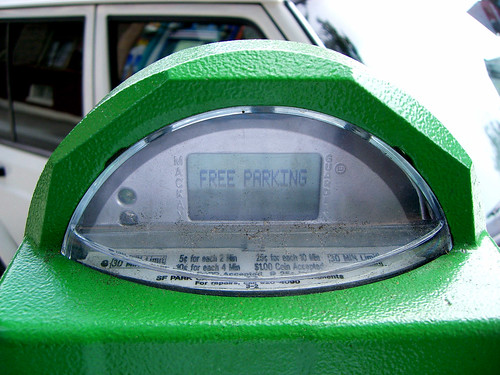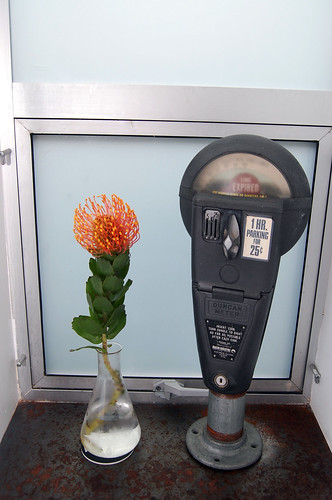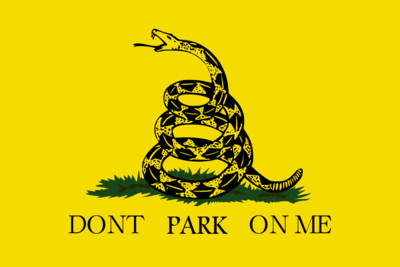When it comes to the SFMTA’s plans for meters in the neighborhood, I have to admit that I don’t have a dog in this fight. When my fiancée and I took up residence here this spring, we chose it for its proximity to her work and the Caltrain stop. She walks two blocks to the American Industrial Center, and I walk three in the other direction to ride a train into the bowels of the peninsula. I sold my car almost right away and bought a new second bicycle. We are arguably the poster children for sustainable transportation.
However, she still has her car. It has an X permit, and it usually stays put unless she needs to pick something up for work or we run errands. That permit (at $100 a year) gives us priority in parking, and lets us hang on to a spot for days. If our building had an off-street parking spot for our unit, we could be charged $150 a month, so we’re getting a pretty good deal.
When we moved here, we were told that parking was easy, and so far this has been true. It was a selling point, and it’s one of those things that you tell friends from around the city when they complain that your home is way off in the sticks. You never have to park more than a block or two away. I have done that parking dance in the city, but rarely here. It’s just not a thing that happens.
That brings us to the big issue: SF Park’s Mission Bay Parking Management Strategy. This document has a number of dubious statements to support an overreaching plan to drastically change the parking plan for the Dogpatch and the landfill areas to our north charitably called Mission Bay. It lumps together three disparate sub-neighborhoods into a “parkingshed:” SOMA is being painted with the same tarry brush as the Dogpatch and Potrero Hill. Finally, it calls for drastic and unfettered expansion. Everything is a nail, because SF Park has new meters as a hammer.

Gooooooooaaaaaaaaaaaaaaallllll! by Telstar Logistics
used with permission
Specious Statements
“the Mission Bay development, which was designed to be a transit-oriented, mixed-use neighborhood” and “Mission Bay was specifically designed to be a transi t-first community to encourage employees, visitors, and residents to access the neighborhood without using an automobile. Rich transit service supports this goal, with several primary transit lines serving the ar ea including the recently completed T-Third light rail line that runs along Third Street.”
Are you kidding me? Only one line services the area: the venereal venerable T-line. The 10 and 22 barely come within half a mile. Getting to the Toronado in the lower haight takes half an hour by public transit, or 11 minutes by car. This isn’t the worst thing in the world, but flies in the face of the stated transit-oriented design. Several? One. Maybe three, but that’s stretching it.
“Additional tran sit service improvements are scheduled for the area.”
This would have been a good place to elaborate. I hope it’s not just the T line going underground at 4th and King. I welcome the opportunity to get directly to Chinatown, but come on. Come. On. That’s years away.
“In November 2002, the SFMTA Board of Directors passed a resolution that established the Mission Bay redevelopment area as an on-street metered parking district, meaning that all on-street parking spaces in Mission Bay would be metered.”
I couldn’t find this resolution online. That doesn’t mean that it doesn’t exist, but it is difficult to gauge their original intent.
“Include the areas surrounding Mission Bay into the South Embarcadero/Mission Bay SF park pilot area and start rates at $0.25/hour.”
SFpark’s Post-launch implementation summary and lessons learned document has a map showing the pilot areas. If expansion into the “Mission Bay buffer” areas were already approved, surely we’d be on the maps. This is a new decision.
San Francisco Transportation Code Division II Article 400 Section 412 (6) defines the South Embarcadero SFpark Pilot Parking Pilot Area thusly:
(6) South Embarcadero SFpark Pilot Parking Pilot Area shall commence at a point where the southerly line of Mariposa Street intersects the easterly line of Terry A. Francois St, thence westerly along the southerly line of Mariposa Street to the easterly line of the CalTrain tracks, thence northerly along the CalTrain tracks to northerly line of King Street, thence easterly along the northerly line of King Street to the westerly line of Fifth Street, thence northerly along the westerly line of Fifth Street to the northerly line of Folsom Street, then easterly along the northerly line of Folsom Street to the easterly line of The Embarcadero, then southerly along the easterly line of The Embarcadero to the southerly line of King Street, thence easterly along the southerly line of King Street to the easterly line of Third Street, then southerly along the easterly line of Third Street to the northerly line of Terry A. Francois St, then easterly along the northerly line of Terry A. Francois St to the easterly line of line of Terry A. Francois St, then southerly along the easterly line of line of Terry A. Francois St to the point of commencement.
This is the new part. Suggestion: write up the changes to the transportation code and let the community see them separately from the flim flam that is calling itself a “management strategy.”
“This strategy focuses on addressing parking demand generated within Mission Bay (AT&T Ballpark, UCSF campus, etc.) and by nearby destinations such as the Caltrain Fourth Street Station and the California College of the Arts.”
If you want to talk about parking generators, you can’t leave out the other big guns, like the 22nd Avenue Caltrain, the American Industrial Center, and MUNI. The 22nd Avenue Caltrain stop boards 864 souls on a weekday morning. We’re the seventh most popular place to get on the train! If we assume that 10% of those people drive themselves and park in the neighborhood, that’s still 86 vehicles. The SFMTA itself says that with free parking available, it is more likely to be 10% not driving. Ouch.
However, this is intermodal passenger transit. In other, less transit-oriented cities, they would revel in the success of our unofficial park-and-ride system. Driving to Caltrain is a win. What the parking plan is missing is any analysis of how to manage this parking. Aside from 4th and King and San Mateo, every Caltrain stop in the top eighteen (and 22nd is number seven for morning boardings!) has designated parking for commuters — and San Mateo has ramps that it shares with its downtown. Mind you, I don’t want to live in Mountain View.
A lot of Muni drivers park next to Woods Yard. I’m just sayin’, it’s a lot.
“The majority of the streets in the Mission Bay buffer have no parking regulations except street cleaning.”
Speak for your own buffer area, there are four hour restrictions through most of Dogpatch.
“A telling indicator of this fact is the California College of the Arts website’s guide for visitors, which states, “On weekdays, a good rule of thumb is to allow yourself at least 30 minutes to find street parking.”
That page no longer contains such a strongly worded warning. Is parking no longer a problem there?
[In Mission Bay] “High occupancy is strongly correlated to unregulated parking; low occupancy is strongly correlated to areas relying on two-hour time limits as a parking management strategy.”
Correlation is not causation. Low occupancy in Mission Bay probably has more to do with there being very little to attract a casual visitor.

Still Life with Parking Meter and Extraterrestrial Plant by Telstar Logistics
used with permission
The Mission Bay buffer
Sigh. This is what has everyone’s goat. Gone are the days of unfettered parking. Gone is the wild west atmosphere with its attendant hope and growth. Soon our neighborhood, too, can be a grim downtown wasteland. Blocks with existing residential permits are said to be safe, and there are now provisions to expand those zones slightly, but the wholesale invasion of meters is infuriating.
As Cory Doctorow of Boing Boing titled a brief blog post: “Parking makes people insane.” He was linking to an article from Dave Gardetta at LA Magazine about parking. In it, there is discussion of Los Angeles’s particular (and particulate) parking problem: there is too much of it. and it is too cheap. An economist named Donald Shoup maintains that transit use and carpooling double when workers have to pay to park. This is pretty reasonable, and I am all for encouraging workers to take transit instead of driving. Unfortunately, San Francisco is hamfistedly applying these ideas.
“The golden rule for office buildings has been four spaces for every 1,000 square feet. But where did that number come from?” Another great point! There’s certainly room to adjust the building codes based on need. How many spaces should there be for Caltrain? How many for the American Industrial Center? These numbers are conspicuously absent. This is all a test, a pilot program, an extension to a pilot program that hasn’t been started.
SF Park’s Mission Bay Parking Management Strategy is misrepresented, contains possible inaccuracies, and paints disparate areas with the same brush and paint. Its suggestions are overreaching, and serve to create a parking problem without supplying solutions.
District 10 Supervisor Malia Cohen raised some excellent issues in her open letter to Jay Primus, parking czar. Enforcement of four hour restrictions is somewhat lax. The parking plan covers this, by changing those restrictions to two hours so that parking enforcement can stay on top of it, but that aspect is in danger of being thrown out with the rest of the document. Transit is “unreliable,” which is a charitable way of saying “haphazard and incomplete.” PDR businesses have different parking needs from commercial businesses. Forcing turnover is not a priority. For those workers, the meters are purely social engineering. I’m sure that we could all use a nudge in a greener direction, but if there aren’t better transit options, a nudge will just get you a dirty look.
Consider figuring out a pay lot or a ramp for Caltrain or for the larger employers. Consider expanding transit now, rather than some time in the future. Consider halting expansion of metered zones until the pilot program is complete. Make a specific plan for each section that you work with. We’re not an parkingshed, we’re not a revenue stream, we’re people, and we just want to park our live/work vans for free have a say in how we are governed.

Don’t Park on Me, by Jesse Mullan
Finally, an observation: double parking is a fantastic traffic calming measure. Speed bumps don’t slow people down, and those weird traffic circles just terrify drivers, but if you have three cars double parked in front of the liquor store, every body slows down when going by — at least a little.

 Dogpatch Howler @DogpatchHowler
Dogpatch Howler @DogpatchHowler
9 Comments
Thanks for using my photos. So now I’ll rant…
SERIOUSLY??!! I’m one of those people who departs daily from the 22nd St. Caltrain station, and the idea that I can get there by public transit is a farce. Not just because it would take me about 40 minutes on public transit (vs. 5 min in my car from N. Bernal), but also because the Caltrain schedule is so sparse that even the slightest MUNI hiccup will cause me to miss my train.
Here’s MY idea: Let’s convert that big Woods Yard bus lot into parking for Caltrain commuters, and let the Muni buses park in that new facility they are building at Islais Creek.
SF needs to get with the program: There are a lot of locals who don’t want to drive to work in the Valley, but the City seems to determined to make that as difficult as possible. The current plan is further proof of that.
I’m happy to pay (a REASONABLE fee) for parking in a Caltrain lot, but the myopic technocrats from SFMTA seem determined to force me into my car for a drive to Silicon Valley rather than trying to help me use public transit to get to work.
Seeeeeeeeeeeeeeeeethe…..
Telstar, Woods Yard Caltrain Commuter Parking would be perfectly located and a great enabler of Park ‘n’ Ride, which is a Good Thing. We are in agreement!
A Woods Yard Caltrain Commuter Parking lot has the Burrito Justice seal of approval. I’d be happy to pay for safe parking.
I’m simply stunned at Muni’s complete disdain for Caltrain’s schedule. (Frankly there should be express buses from the station to various neighborhoods, but that’s a different discussion.) Why there isn’t a bus timed for Baby Bullet departures, and another sitting and waiting for Caltrain arrivals — especially at night — is beyond me.
Oh, and the last 48 of the night leaves before the last Caltrain arrives. I tip my hat to the contempt Bay Area transportation agencies have towards their customers.
You make the point that all these Caltrain stations have designated parking. Those parking lots cost… $4 per day. The proposed meters will be… $2 per day….
And if you live 3 blocks from Caltrain, then you live 3 blocks from the 48 bus.
@BurritoJustice – word on MUNI’s general lack of thinking on connectivity to 22nd Street. Why is that? Consider, I was discussing taking the 48 to Caltrain with a SF Supervisor Candidate – who could not figure out how I could take the 48 to Caltrain, because said Candidate did not know the station existed.
City Hall thinks we went directly from “People take Caltrain to get to downtown” to “There are some reverse commuters who take Google buses” Noe and (part of the) Mission have nominal connectivity with the 48 but otherwise it’s drive or bike (down Chavez!). Of course, experience shows that a lot of those cars in the (oversubscribed) parking near 22nd Street started their journey at someplace like 20th and Connecticut.
John,
“Prices will then vary by demand changing no more frequently than every four weeks and by no more than $0.25 per hour.”
Yes, parking at an average Caltrain station is $4 for twenty four hours. Parking at a new meter would start at $2 for eight hours, with $2.25 being the full nine-hour charge. However, if the meters are full (and SFpark promises that they will). After three months, it could be $8 a day to park and ride. None of this matters directly to me because I walk to the train, but lots of people do and it is completely valid.
Indeed, I live one block from the 48 bus, and one or two (long) blocks from the T and the 22. However, what I took issue with was this statement: “Mission Bay was specifically designed to be a transi t-first community to encourage employees, visitors, and residents to access the neighborhood without using an automobile. Rich transit service supports this goal, with several primary transit lines serving the ar ea including the recently completed T-Third light rail line that runs along Third Street.”
Yes, I want more transit options, and I want them to be better coordinated with Caltrain. Transitions should be easier from mode to mode, whether they be feet, bikes, buses, trains, or even cars. I can’t even argue against meters — I just want a plan that actually considers the parking needs of the area, and is expressed with honest and direct communication.
well, really it’s $2.25 for 24 hours, n’est pas 😉
If the meters are full, what do you suggest? I lived on Potrero Hill for 6 years – pre-dating the X RPP on Pennsylvania. The growth in usage of 22nd and the resultant pressure on parking there has been impressive. The area also used to be a lot more sketchy and people cheered every remodel or new loft, and every new business. You don’t get to become Noe Valley for free.
Do you think this is mostly an imposition on Potrero Hill residents, or on Bernal Heights and Castro Caltrain commuters?
The obvious suggestion to us mere plebes is a 48X bus that stops in West Portal, Miraloma, Clipper/Portola, Noe/26th, Valencia/Chavez, Folsom/Chavez, Caltrain. On the 30 minutes, meeting the 314/220 series buses. Run a 33X from the Haight down 18th and extend it to Caltrain.
Since we clearly “don’t understand the issues” (e.g. that’s not going to happen) – what do we do?
Seriously the morons in Room 200 and SFMTA think the T line = transit rich! You can take LRV’s everywhere!
I think we’re mostly in agreement and I would love to have heard a discussion like this. There are lots of things that should have been called out into specific points. What should be done with Caltrain parkers? Should they be encouraged? Can they be shifted to new or altered bus routes? How many spots are being constructed for Salesforce? Will they have additional transit service? What retail is going into Mission Bay and what kind of parking will it have? Ramps? Lots? Street? Are there bicycle parking allocations?
Actually, there will be plenty of meters to lock up to, so I will have a place to lock my bike every twenty feet or so. I take everything back — all ahead full. Damn the torpedos.
I’ve been in the Patch for 19 years. This city is run by the most moronic people I’ve even had the displeasure of being governed by. Can’t wait to get to Portland! MAX into the airport and it runs on the real schedule!
2 Trackbacks/Pingbacks
[…] on Neighborhood Opposition to SFPark’s Mission Bay Plan (SFBG, SF Exam, Dogpatch) More headlines at Streetsblog Capitol Hill Email Share […]
[…] that parking will be even more tied up, 7×7 magazine has run two articles in quick succession about the […]